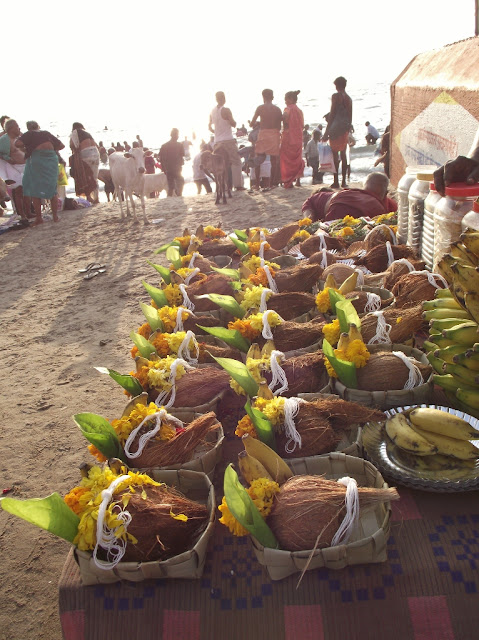Wandering the beaches in southern Tamil Nadu is an
eye-opening experience. It's a beach-comber's delight - or nightmare, depending
on how squeamish you are. Broken woven baskets encrusted with
dried fish detritus, coils of abandoned fishing net, the severed heads and
tails of puffer fish and stingrays, and, least appealing, ubiquitous cow pies -
or what would be called cow pies if they were made by cows and not people.
Millions of fish corpses lay spread on the sunbaked earth, slowly drying in
preparation for the fishmeal market. The acres of scaly bodies are so salty, so
dry, that not even the black and grey Indian crows perched on the rooftops are
tempted by them.
The beaches of the Gulf of Mannar
biosphere reserve are not exactly what I expected. Being the starry-eyed,
naive conservationist that I am, words like "biosphere reserve",
"community-based conservation", and "UNESCO" make me think
of tidy landscapes, prosperous people, and sustainable natural resource use.
Let’s just say that there is still some work to be done in the Gulf of Mannar.
In India
the designation "biosphere reserve" has no legal status. So the
waters lapping at these busy and littered beaches have no more protection than
any other piece of coastal water. However, areas with the biosphere reserve
label do get a little more attention and funding than the average chunk of
landscape crying out for a little conservation.



The Gulf
of Mannar was the first marine biosphere reserve in south-east Asia. These coastal waters of Tamil Nadu are extensively
studied and support between 3,600-5,000 different species, making it one of the
richest coastal regions in Asia. Although fishing is allowed in the reserve, it
is not allowed in the core area, the Gulf of Mannar
marine national park, which encompasses the waters 500 meters offshore a series
of small islands stretching down the coast. National park is a much more rigorous
management category than biosphere reserve. The wildlife warden of the national
park and personnel from the Forest Department work together to manage human
impacts in the area.
There is no doubt that the Gulf of Mannar
is heavily over-fished. Illegal exploitation even occurs within the national
park. Buoys were recently installed to
delineate the edges of the protected area, but local fishermen quickly cut them
loose to prevent strict enforcement. At the time of my visit state elections
were only a few weeks away. In a triumph of political expediency over law
enforcement, the incumbent politicians were deliberately refraining from
enforcing the boundaries of the national park until after the elections in an
effort to please voters.





In Ramanathapuram
I met with an employee of the Gulf of Mannar Biosphere Reserve Trust, a
public-private partnership organization working on sustainable development and
livelihood issues in the national park and biosphere reserve. He described to me the incomplete regulatory
framework governing India’s
fisheries and marine resources. The
Marine Fishing Regulation Act focuses entirely on the economic aspects of
fishing and has no conservation focus.
Lack of enforcement is also a problem. Although regulations state that
fishing net mesh size should be no smaller than 5cm, mesh sizes of 1.5-2 cm are
common. Although the waters between the shoreline and 5km offshore are reserved
for artisanal fishing, commercial trawlers commonly operate within the 5km
limit. Fishermen have been trained (and
are required) to use turtle exclusion devices (TEDs) and juvenile (fish)
exclusion devices (JEDs), but commonly use neither, as these technologies can
cause them to lose 12-15% of their catch, a loss they are not prepared to
endure. Because most trawlers are owned by rich businessmen living away from
coastal fishing communities, the economic benefits of fishing are often not
experienced by local fishermen. The cost of a trawl fishing boat is in the
range of 30 lakh rupees (3 million dollars), far beyond the reach of actual
fishermen. These rich trawl owners are politically well connected, ensuring
nothing has been done to make trawl fishing more sustainable in over two
decades. An additional complication in
this region is the narrowness of the exclusive economic zone between India and Sri Lanka. The waters are shallow
with ever-changing patterns of sedimentation, forcing fishing boats to
sometimes stray into the other nation’s waters.
But despite these issues, in some ways the Gulf of Mannar biosphere reserve is a model for public-private
conservation partnerships and innovative programs. The Gulf of Mannar Biosphere Reserve Trust, jointly
funded by the Government of India and the Global Environment Facility (GEF),
runs a number of programs in rural fishing communities in coastal Tamil Nadu. One major focus is capacity building. In the
last several years almost 250 eco-development committees, each serving between
5-20 villages, have been developed. These committees manage microcredit
programs, administer small grants for alternative livelihood training, and
educate youth. The Trust promotes some
alternatives to fishing such as jasmine and betel leaf cultivation, making
charcoal, palm jaggery, plaster of paris dolls and idols, salt, and shared
autos. It was also instrumental in
getting plastic bags banned in the region, installing public, pay-to-use
toilets, and building a centralized fish market to allow better communication
between fishermen and better hygiene and display of the catch. One major success of the Trust’s programs
has been to eliminate high interest rate money lenders by starting its own low
interest micro-credit scheme.
Additional threats to the Gulf
of Mannar biosphere reserve are untreated sewage, nearby
industrial plants releasing effluent, and over-harvesting of seaweed from the
shallow waters around islands in the reserve.
Dynamite and cyanide fishing and coral mining have been completely
stopped thanks to the work of the Trust.




















































